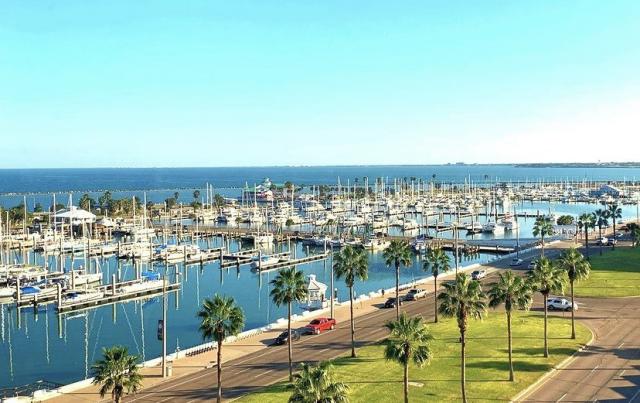Also see the Checklist of the Birds of Corpus Christi
-
- Blucher Park Behind the central library near downtown, entrance on the 100 block of Carizzo St. One of the top spots for migrating songbirds. Guided bird walks on weekends in April (except Easter) at 7:30-l0:30 am. Best in migration.
- Rose Hill Cemetery Entrance at the corner of Comanche St. and Palm Dr. Rose Hill is a designated bird sanctuary and another top spot for migrating and winter songbirds in the numerous mature live oaks. Best in migration and winter.
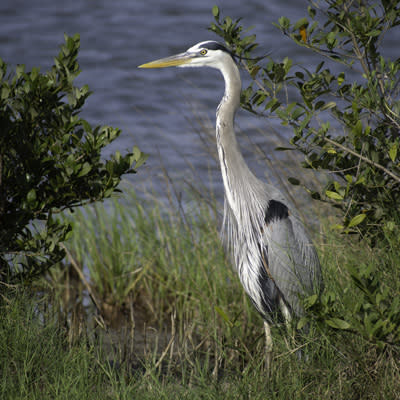 Texas A&M Corpus Christi Campus and NAS Causeway Hike and bike trail overlooks flats of Oso Bay. Enter from 6300 Ocean Drive and ask at the kiosk about parking. Follow the hike and bike trail marked by white lampposts around the south shore of the island. Shorebirds, waders, gulls and terns. Continue east on Ocean Drive past the university and bird along the Oso Bay side of the Naval Air Station Causeway (usually closed on weekends). Good for Snowy, Piping and Wilson's Plover and whimbrel (in spring). Best fall to spring.
Texas A&M Corpus Christi Campus and NAS Causeway Hike and bike trail overlooks flats of Oso Bay. Enter from 6300 Ocean Drive and ask at the kiosk about parking. Follow the hike and bike trail marked by white lampposts around the south shore of the island. Shorebirds, waders, gulls and terns. Continue east on Ocean Drive past the university and bird along the Oso Bay side of the Naval Air Station Causeway (usually closed on weekends). Good for Snowy, Piping and Wilson's Plover and whimbrel (in spring). Best fall to spring.- Hans A. and Pat Suter Wildlife Refuge Nature park with a boardwalk on the shore of the Cayo del Oso. The entrance is at the intersection of Nile Dr. and Ennis Joslin Rd. Egrets, herons and ibis are present year-round along the boardwalk and at the overlook. Shorebirds are mostly July through April. Many ducks in the winter. Also butterflies, wildflowers and native plants.
- South Texas Botanical Gardens & Nature Center 8545 South Staples. Over 180 acres of native habitat, natural wetlands and floral exhibits. Ornamental flowering plants attract hummingbirds and butterflies. A bird and butterfly trail leads to an overlook at the pond, where ducks, grebes and shorebirds may be found. Allow time to explore the plant life as well as the birds. Inquire about educational seminars and workshops. Facilities, fee. They also organize the annual Birdiest Festival in America. Check with Botanical Gardens on times, programs, etc.
- Tule Lake A tidal lake on Up River Road. Take Exit 6 off 1-37 and follow Southern Minerals Road north toward the river. Turn left on Up River Road and proceed to the overlook. Shorebirds, ducks, pelicans, spoonbills, egrets, gulls, terns, ibis and wood storks in summer. Good all year, but best in migration and winter.
- Hilltop Nature Area This is a tract of native vegetation and arroyos at 11425 Leopard Street. Take the Violet Street exit from 1-37, go south on Violet and turn right on Leopard. About 0.3 miles west of Violet turn left into Hilltop. Stay to the right and park near the play area and the big BBQ pit. There is a network of paved hiking trails through the park. Migrants and South Texas specialties. Facilities. Good all year but best in migration.
- Pollywog Ponds A heavily wooded area off Up River Road. When coming from the east, take the Sharpsburg Road exit from 1-37, stay on the frontage road, go right at the Great Texas Coastal Birding Trail sign, left on Up River and sharp right into Pollywog. Pollywog has two entrances, use either one. Walk the diked area around three settling ponds. Waterbirds, songbirds and migrants. One of the top birding spots in the Coastal Bend. Good year round, but best in migration and winter.
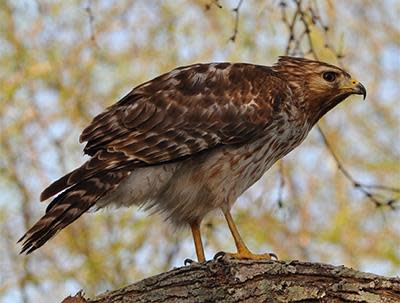 Hazel Bazemore County Park A brushy, wooded park on the Nueces River. Home to the Hazel Bazemore Hawk Watch conducted August 15-November 15. Go west on FM 624 from US 77 and turn right at the stoplight at County Road 69. At the park entrance, turn left to go to the hawk watch platform or continue straight, down the hill toward the Nueces River. Turn left at the bottom of the hill to get to a boardwalk and overlook for the small pond or right to get to a nature trail. The road passes along the Nueces River and several acres of wetlands. Ducks, shorebirds, wading birds, rails. Good for Green Jay and other South Texas specialties all year and bluebirds and Marsh and Sedge Wrens in winter. The hawk migration in fall can be spectacular. Facilities. Check on times when park is open.
Hazel Bazemore County Park A brushy, wooded park on the Nueces River. Home to the Hazel Bazemore Hawk Watch conducted August 15-November 15. Go west on FM 624 from US 77 and turn right at the stoplight at County Road 69. At the park entrance, turn left to go to the hawk watch platform or continue straight, down the hill toward the Nueces River. Turn left at the bottom of the hill to get to a boardwalk and overlook for the small pond or right to get to a nature trail. The road passes along the Nueces River and several acres of wetlands. Ducks, shorebirds, wading birds, rails. Good for Green Jay and other South Texas specialties all year and bluebirds and Marsh and Sedge Wrens in winter. The hawk migration in fall can be spectacular. Facilities. Check on times when park is open.- Packery Channel County Park Take the JFK Causeway (Park Road 22) east onto Padre Island, take a left at the sign for the county park. Go to the end of the road and bird along the channel. Waders, shorebirds, gulls, terns, spoonbills. Good all year.
- Packery Channel Oak Motte Sanctuary After turning off PR 22 into Packery Channel County Park, take the first right onto Sand Dollar Street. Go one block and turn left to the Audubon Outdoor Club Boardwalk, overlook, and Leah's Pond. The two blocks enclosed by Sand Dollar, Maria Isabel, Playa del Rey, and Verdemar have oak mottes and other vegetation which is very attractive to migrants in spring. Numerous rarities have turned up at Packery over the years. Best in spring.
- Padre Island National Seashore and Bird Island Basin Drive south down Park Road 22 to Padre Island National Seashore. A few miles past the entrance, a side road goes to the right to Bird Island Basin. In wet years the marshes along this road and PR 22 can be very good for ducks, gallinules, waders and grebes. In winter, watch for Peregrine and Merlin and for White-tailed Hawk and Crested Caracara all year. Further down PR 22 is the Malaquite Visitor Center with several displays and educational exhibits. Facilities. Past Malaquite the road goes to the beach which can be driven south for over 50 miles (four-wheel drive only past the first few miles).
- Mollie Beatty Coastal Habitat Community On TX 361 about 1.5 miles north of the intersection with Park Road 22. Walking trail along tidal flats. Piping Plover habitat as well as other shorebirds and herons, egrets, gulls and terns.
- Mustang Island State Park The entrance is on TX 361 about five miles north of the intersection with Park Road 22. Birding on gulf beach, in dunes, and on flats along the bay. Facilities, entrance fee. Contact park for hours of operation.
- Gulf Beaches of Padre Island, Mustang Island, Packery and Port Aransas Jetties The access roads to the beach are well marked along TX 361 on Mustang Island and Park Road 22 on Padre Island. Driving along beaches is possible except during storms and very high tide. The Port Aransas jetty is at the north end of Mustang Island and the Packery jetties are on either side of Packery Channel between Mustang and Padre Islands. Numerous gulls, terns, shorebirds and Brown Pelicans can be seen along the beach. Occasionally rarities can be seen from the ends of the jetties. Good all year.
- South Boardwalk at Charlie's Pasture A boardwalk goes about a half mile across tidal flats and pools, with a tower overlook. An excellent site for shorebirds, herons, ibis, spoonbills, particularly Snowy, Piping and Wilson's Plover. The entrance is off TX 36 l near the south end of Port Aransas. Turn west just south of where the yellow "airplane" is flying into the ground. Best in migration.
- Port Aransas Wetlands Park In the southern part of Port Aransas on Highway 361 opposite the Post Office. The tidal flats in front of the overlook can be very good for shorebirds, waders, gulls and terns.
- Scott and Joan Holl Paradise Pond On Cutoff Road 0.3 miles south of Cotter St (the road which leads to the ferry slip). A small sign indicates the turnoff to the parking lot. This is a boardwalk around a willow-lined freshwater pond. One of the best spots for migrants in spring and good also in fall. Butterfly garden.
- Leonabelle Turnbull Birding Center This is one of the best sites in Port Aransas. Turn west on TX 361 where that highway leaves Alister St at the stoplight. Follow the signs to the parking lot. The entrance path goes by a cattail marsh and a few trees which can harbor migrants in spring. The path leads to a boardwalk over a large freshwater pond with an observation tower. Ducks, Least Bittern, Roseate Spoonbill, egrets, hawks, shorebirds, gallinules, rails and two alligators. Guided bird walks on Wednesdays at 9:00 am. The ducks and wading birds are quite tame and offer great opportunities for photographers.
- North Boardwalk at Charlie's Pasture A boardwalk goes about a half mile across tidal flats and pools, with a tower overlook. An excellent site for Horned Larks and Reddish Egret (both color morphs) as well as other herons and shorebirds. If coming to Port Aransas via the ferry, take the first right, on Cutoff Road and take an immediate right on Port St. Follow Port to the water and continue to a pavilion. In front of the pavilion take the trail to the right. If coming from the south, follow TX 361 until just before the ferry slip and turn left onto Port St. Best in migration and winter.
- Live Oak Park In Ingleside. Take FM 1069 south to sign for Live Oak Park Entrance B. Extensive live oak and bay bushes make this site attractive for migrants. In the back of the park is a small pond. Heavy weekend recreational use. Facilities. Best in migration.
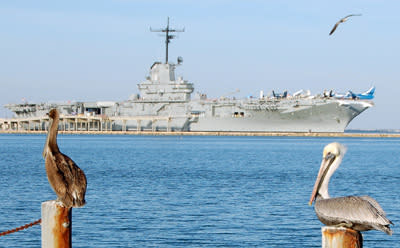 Indian Point Park Whether heading north or south on TX 35/US 181 exit at the signs for Indian Point Park. A boardwalk overlooks salt marshes which harbor Clapper Rail all year round. Willet, Reddish Egret, American Oystercatcher and other shorebirds, waders, gulls and tern. Facilities. Good year round.
Indian Point Park Whether heading north or south on TX 35/US 181 exit at the signs for Indian Point Park. A boardwalk overlooks salt marshes which harbor Clapper Rail all year round. Willet, Reddish Egret, American Oystercatcher and other shorebirds, waders, gulls and tern. Facilities. Good year round.- Sunset Lake Going north from Corpus Christi on TX 35/US 181 take the Moore Ave. exit in Portland, turn right on Moore Ave. and then in a few blocks bear right on Sunset and go down the hill. Sunset Lake is on the right and Corpus Christi Bay on the left. The sandy flats on Sunset Lake (if tide is right) are good for Snowy Plover and other collared plovers. Shorebirds, waders, common loon in the bay. A hike and bike trail goes from the parking lot to Indian Point Park
- Fred Jones Nature Sanctuary Sanctuary maintained by the Audubon Outdoor Club. From TX 35/US 181 take the Moore Ave. exit in Portland and go west for 5.7 miles on FM 893 to a four-way stop. Turn left, go about 0.5 miles and the sanctuary is on the left. Park on the east side of the road and walk in. Breeding birds in summer and migrants in spring and fall. Butterflies and native plants.
- John J. Sablatura County Park On TX 44 one mile west of Banquete. Woodsy park on Agua Dulce Creek open 7 am to 9 pm. Long-billed Thrasher and Green Jay all year round, sparrows and Eastern Bluebirds in winter. Facilities. Check with park on times.
- Wright Ranch Pond Take FM 624 west to the intersection with FM 666 and turn right. Go about 0.9 miles and park on a pull off on the right just before the bridge. This is a wooded pond on a private ranch. The back side of the pond is a roosting area for herons, egrets, spoonbills, Anhinga, Wood Stork and cormorants. Hundreds of birds can concentrate here in late afternoons, particularly in the late summer and fall.
- McGloin Road From the junction of FM 624 and FM 666 go north on 666 to San Patricio and turn right on McGloin Road. Leisurely birding along isolated flooded old gravel pits. 1.7 miles to the end of the road at a gate. Best in winter
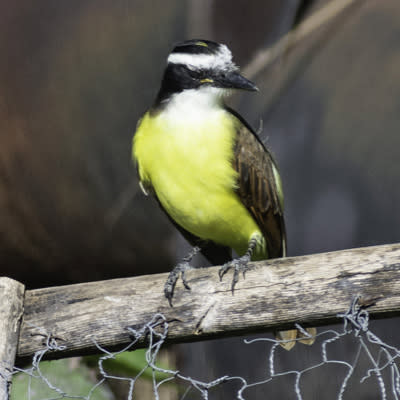 Sandia/Knolle Farms Area This area is primarily pasture, fence rows, ponds and a large dairy farm. Take FM 624 west to the junction with FM 70 and go north on 70. Where 70 takes a sharp turn to the left, continue straight on a small county road. This curves to the left past the dairy farm and becomes Jim Wells County Road 360. Where CR 360 crosses FM 1540, you can go straight on 360 or go right on FM 1540, or do both. In wet years the ponds have ducks, waders and shorebirds. This area is good for sparrows and hawks in winter and is one of the most reliable locations for Ferruginous Hawk. From the little town of Sandia you can continue on north on TX 359 to Lake Corpus Christi State Park
Sandia/Knolle Farms Area This area is primarily pasture, fence rows, ponds and a large dairy farm. Take FM 624 west to the junction with FM 70 and go north on 70. Where 70 takes a sharp turn to the left, continue straight on a small county road. This curves to the left past the dairy farm and becomes Jim Wells County Road 360. Where CR 360 crosses FM 1540, you can go straight on 360 or go right on FM 1540, or do both. In wet years the ponds have ducks, waders and shorebirds. This area is good for sparrows and hawks in winter and is one of the most reliable locations for Ferruginous Hawk. From the little town of Sandia you can continue on north on TX 359 to Lake Corpus Christi State Park- Lake Corpus Christi State Park and City of Corpus Christi Wildlife Sanctuary Take Exit 34 from 1-37 and follow TX 359 for 5.5 miles. Turn right on Park Road 25. After a short distance there is a small parking lot on the left with a trail into the Corpus Christi Wildlife Sanctuary. The trail goes through pasture and woods nearly to the spillway for the dam. Stay on the mowed paths as poison ivy is prevalent. Further north on PR 25 there is a second parking lot with a trail which intersects the first one. The area below the dam is good for winter songbirds. Continue north on PR 25 to Lake Corpus Christi State Park. The park, especially the dry brushy areas in the center, is good for many of the South Texas breeding bird specialties such as Green Jay, Long-billed Thrasher, Brown-crested Flycatcher and Olive Sparrow. Listen for owls at night. Entrance fee, facilities, may be crowded on weekends. Good all year. Check with park for hours of operation.
- Choke Canyon State Park Take Exit 69 from 1-37 and turn west on TX 72 and follow that through Three Rivers to the park. There are two sections to the park with the Calliham Unit being much the better. This is another good site for breeding birds including Audubon's Oriole, Long-billed Thrasher, Black-throated Sparrow, and Olive Sparrow. There are ducks and water birds on the 75-Acre Lake and the main body of the lake. Entrance fee, facilities, may be crowded on weekends. Good all year. Contact park for hours of operation.
- Rockport Area Little Bay, off Broadway Street, and the Connie Hagar Cottage Sanctuary, Church and 1st Street, are just two of the birding sites in Rockport. Contact Rockport Chamber of Commerce.
- Cape Velero From the intersection of TX 35 and FM 1069 in Rockport, go west on FM 1069 and go right at the sign to Cape Velero. The road winds through grasslands and salt marshes. Seaside Sparrows are present year-round and there are numerous water birds, as well as ducks in winter.
- Goose Island State Park Take TX 35 north across the Copano Bay Causeway and turn right on Park Road 13 and follow that road to the park entrance. There is good birding in the extensive live oak mottes as well as along the bay and adjacent salt marshes. Entrance fee, facilities. Best in migration and winter. Contact Park about opening and closing times as well as the schedule for the guided bird walks in the winter.
- Aransas National Wildlife Refuge Take TX 35 north from Rockport and turn east on FM 774 and then right on FM 2040 (follow the signs) to the entrance. This is the winter home of the Whooping Cranes, which can usually be seen (at a distance) from the observation tower at the end of the two-way road. Many other ducks, water birds and song birds can be found along the way. The one-way auto tour loop is open sunrise to sunset. Entrance fee, facilities. Bring insect repellant. Visitor Center. Check on the times.
- Kingsville Area Contact Kingsville CVB and King Ranch.
An excellent source, listing most of the sites above, with directions and expected species, is the brochure for the Great Texas Coastal Birding Trail, the Central Coast "loop" put together by Texas Parks & Wildlife.

